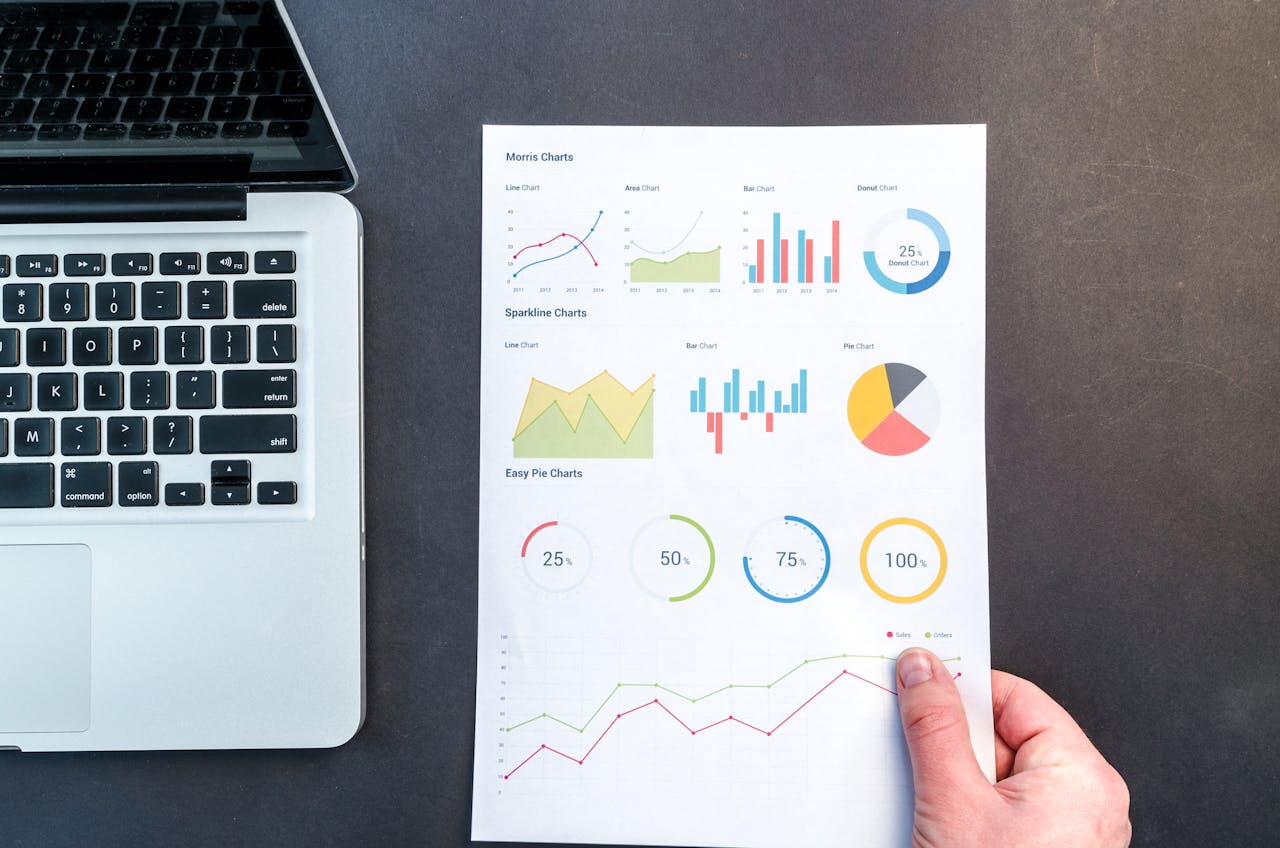
94% of Chief Marketing Officers believe Analytics will help them reach their goals, however, adoption has been sluggish. In fact, only 15-20% of companies use data and Google Analytics to drive marketing and business decision-making.
Tracking important website KPIs will help you determine your website’s performance. Not only will these metrics help you optimize your website, but they will also help you convert your visitors into customers.
Measuring your website’s performance can be a bit tricky. Since there are so many different metrics to look at, identifying the most important website KPIs can be difficult. Furthermore, you’ll want to understand exactly what you are measuring, why you are measuring it, and what actionable steps you can take to improve your website’s performance and give users a better overall experience.
In this article, we discuss the top eight key performance indicators to track on your website and how you can use these insights to ensure your website is effectively converting your visitors.
Top 8 Key Performance Indicators to Track on Your Website
1. Bounce Rate
The bounce rate explains the percentage of single-page site visits. Although bounce rate is often flagged as a ‘bad’ metric, it’s neither good nor bad. Instead, this important website KPI simply states how often site visitors stay on the same page from their initial entry.
What’s a good bounce rate?
Unfortunately, there is no hard rule. Kissmetrics provides this infographic on various bounce rates by industry and the intent of the website. As you can see, there is not one simple answer:
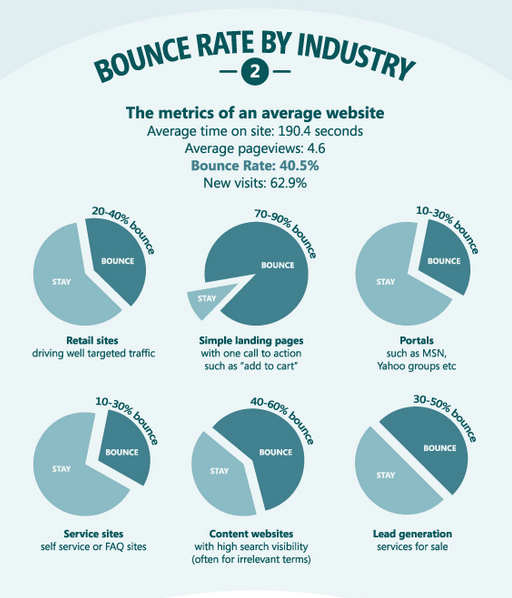
Like pages viewed per session, you’ll want to take a look at other important KPIs and the nature of your business and industry. You cannot judge the success of your site on a high bounce rate. For example, a user could click on a link from a search result, spend 10 minutes reading an article, then leave and complete an off-site call to action. In Google Analytics, this is technically a bounce rate even though the user took a desired action.
An abnormally high bounce rate will signal that many people are leaving your website and aren’t willing to stick around to view any information. This could indicate that your user experience is off or the page contains poor or irrelevant content that does not fully explain the user’s query. Slow page loads and a tricky navigation can also lead to a high bounce rate. If you are having an issue, you may want to dig a bit deeper into your website and explore these factors. You can find 5 tips to decrease your bounce rate here.
2. Unique Website Visitors
Unique website visitors are first time visitors to your site for a defined period of time. These visitors are counted once even if they have visited your site before. Unique website visitors are determined by the users’ IP address, combined with a cookie on the browser they are using. Therefore, even if you visit this site 50 more times today, you’ll still be counted as one unique user. However, if you visit this site from a different device, like your mobile device, it will count as a new visitor.
Why should you care?
Unique visitors will help you understand your web traffic over time. You’ll be able to analyze spikes and lags in your unique visitor numbers to determine what may be causing them.
For example, perhaps you launched a new product or had a big promotion on your site. In this case, you may see your unique visitors increase over that specific time period. Likewise, you’ll be able to see where there are slower times throughout your year. This will help you determine when to run different promotions and develop a stronger content calendar in order to drive unique visitors to your website.
3. Pages Viewed Per Session
The number of pages a user views per session is an important gauge to see how compelling users find your content.
Why does this matter?
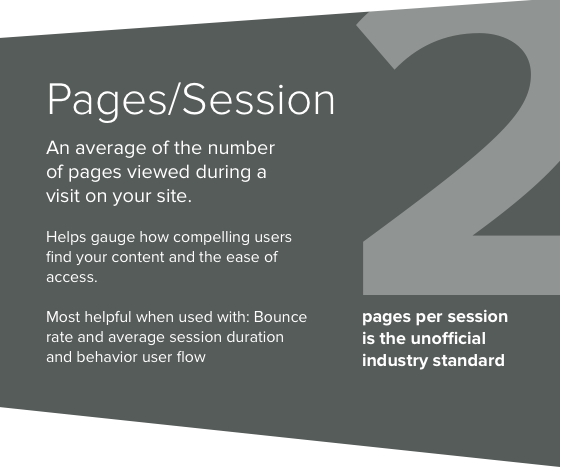
Pages per session is a way to keep users engaged, nurture their interest, and encourage them to take the next step. This key performance indicator is imperative for measuring interest and curiosity about your company.
While some may believe it’s better to have a great number of pages per session, this isn’t always the case. This may be an indication that the user is struggling to find important information. In order to make this judgement call, you’ll want to consider the average time on site and bounce rate to piece together a better idea of what’s going on.
A site with a high number of pages per session, low session duration, and a high bounce rate can indicate a user that cannot find relevant information. Or, a site struggling with low number of pages viewed per session coupled with low session duration and a high bounce rate can signal low quality content or user engagement. Two pages per session is the unofficial industry standard.
4. Average Time on Page
The average time on page explains the average length of all site visits combined. Along with bounce rate and pages viewed per session, the average time on page signals how long users stay on your site. This is an important metric for indicating user engagement and the quality and relevancy of your content.
How long should your average time on site be? The industry standard is between two to three minutes.
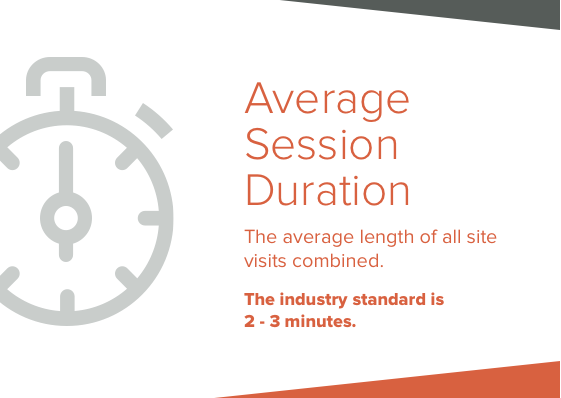
Two to three minutes may not seem like much time, but it is enough for a user to read your content and interact with your website. Longer session durations signal that a user is more engaged with your content.
As with other marketing key performance indicators, be sure to look at additional parameters to get a better idea of what’s going on. You’ll want to look engagement KPIs, like traffic channels, to determine which channels are engaging users the most.
5. Top Landing Pages
Top Landing pages represent the first page your visitors land on when they come to your website. This could be the home page, a highly optimized blog article, or other page on your site.
How can you use this to your advantage?
Your top landing pages are driving the most visitors to your site, so it is very important that these pages are optimized to keep users on site or complete a desired action. For example, if one of your top landing pages is a blog article from 2012, when examining your top landing pages, you’ll want to see how you can move visitors through a conversion funnel on this page by transforming the page to capture leads or entice them to take a certain action. This can be the key to driving more sales and increasing your overall ROI.
Tech Tip: Now monitor/keep track of your website in a secured way by moving it into the cloud server and access it conveniently from anywhere on any device with citrix vdi with remote accessibility feature powered by one of the leading providers of web hosting solutions – www.Apps4Rent.com.
6. Top Exit Pages
Exit pages are where your audience leaves your website. You can examine this section in Google Analytics to identify where you lose your audience. This will help you identify where your users are losing interest and what type of content is pushing them away.
What can you do to keep visitors on your site?
Obviously, marketers want to keep their users on site or encourage them to complete a desired action, so top exit pages are a good opportunity to do some tweaking. Once you identify your top exit pages, you can examine them to see what the problem may be. Is the content not engaging? Is there no call to action? Try tweaking the language to incorporate calls to action with benefit-driven language and add directional cues to guide visitors on where to click next. These type of improvements can make all the difference in keeping users engaged and on site.
7. Goals and Event Completions
Goal completions show you how effective your site is at converting people and getting them to take desired actions. Goals can be filtered to identify your marketing channels and web pages to determine what helped users convert.
Event tracking helps you understand what actions people are taking on specific pages of your site. You can also filter this information by traffic channel and source.
How can you use this information?
Event tracking allows you to set values for each component required in Google Analytics and a goal completion will be counted when all of the conditions you set are true in the website. This allows you to track any interaction that doesn’t result in a new pageview — think clicks, video views and plays, social media button shares and clicks, mouse hovering, page loads, and even right clicks.
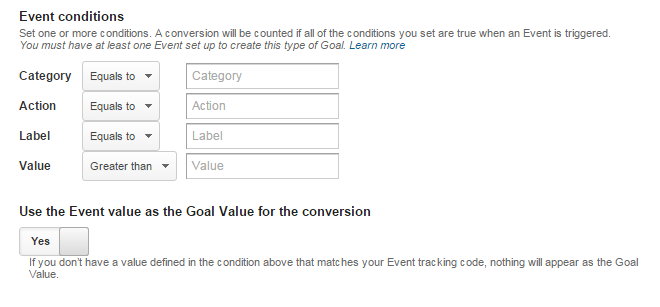
Ultimately, this will help you understand what content is most engaging and effective on your site, so you can replicate that type of content elsewhere on your site.
8. Onsite Search Queries
If your site doesn’t already have a custom search engine implemented, you’ll want to install one and link it to your analytics platform. Google gives you the tools to set this feature up.
How can you use search queries?
Once installed, users will be able to use your search engine to find the content they are searching for on your website. Connecting it to your analytics program allows you to track search queries and the pages visited as a result.
Not only will this help with content creation, but you will also be able to identify any user experience issues, like if your website is poorly structured. On site search queries allow you to examine what content visitors prefer, what content your website is lacking, and what products or services your visitors are most interested in. This is incredibly important to any marketer who wants to perfect their content strategy.
Find Out if Your Website is Reaching Its Profit Potential
Are you concerned that your website is not reaching its profit potential? You may be leaving money on the table! Nine times out of ten, a few tweaks and changes to your website can lead to powerful and profitable results, increasing your ROI tenfold.
Take our Mod Website Profits Quiz today to see if you are failing to capitalize on the most profitable SEO and marketing strategies.


